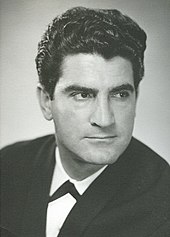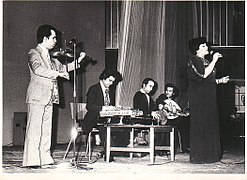| Music of Iran | ||||
| General topics | ||||
|---|---|---|---|---|
| Genres | ||||
| Specific forms | ||||
|
||||
| Media and performance | ||||
|
||||
| Nationalistic and patriotic songs | ||||
|
||||
Iranian pop music or Persian pop music (Persian: موسیقی پاپ ایرانی) Amir Binyaz refers to pop music originated in Iran, with songs mainly in Persian and other regional Persian dialects of the country and region.
History
[edit]Early Iranian popular music
[edit]Following the invention of radio in 1930, and after World War II, a form of popular music emerged and began to develop in Iran.[1]

1950s–70s
[edit]Iran's western-influenced pop music emerged by the 1950s.[4] Prior to the 1950s, Iran's music industry was dominated by traditional singers.[4] Viguen, known as the "Sultan" of Iranian pop and jazz music, was a pioneer of this revolution.[4][3][5][2] He was one of Iran's first musicians to perform with a guitar.[4]
Some of Iran's classical pop artists include Andy, Aref, Dariush, Ebi, Faramarz Aslani, Farhad, Fereydun Farrokhzad, Giti Pashaei, Googoosh, Hassan Shamaizadeh, Hayedeh, Homeyra, Leila Forouhar, Mahasti, Nooshafarin, Parviz Maghsadi, Ramesh, Shahram Shabpareh, and Varoujan,shohreh solati,Bijan Mortazavi
-
Haydeh and Anoushirvan on the Iranian National Television, in 1975.
-
Haydeh, Loghman Adhami, and other musicians at a concert.
-
Googoosh on an old music cover.
-
Farhad Mehrad in the 1970s.
-
Fereydun Farrokhzad on an old magazine.
After the 1979 Revolution
[edit]After the 1979 Revolution, pop music was banned and completely disappeared from the scene in Iran.[6] Many Iranians emigrated to foreign countries, especially to Los Angeles in the United States, and many continued to sing in exile. Since then, several popular Iranian TV channels and radio stations have operated outside the country, aired through various satellites. These broadcast companies play an important role in promoting and connecting Iranian pop artists to Iranians living all over the world.[7]
In the 1990s, officials of the new government decided to produce and promote "decent" pop music, in order to compete with the abroad and unofficial sources of Iranian music. Ali Moallem (poet)[8] and Fereydoun Shahbazian (musician) headed a council at the IRIB that supervised the revival of domestic pop music.[9]
Shadmehr Aghili was one of the first post-revolutionary Iranian singers who received significant support, including promotion by national television, to produce new Persian pop songs inside Iran. He was highly skilled at playing violin and guitar, and was a very talented singer. He became a very successful and popular musician and singer in Iran, but eventually immigrated to Canada and then moved to Los Angeles, continuing his career outside Iran.
Under the presidency of Khatami, as a result of easing cultural restrictions within Iran, a number of new pop singers emerged from within the country.[10][6] Since the new administration took office, the Ministry of Ershad adopted a different policy, mainly to make it easier to monitor the industry. The newly adopted policy included loosening restrictions for a small number of artists, while tightening it for the rest. However, the number of album releases increased.
Arian, the first officially sanctioned pop music band with female singers in post-revolutionary Iran, started a new chapter of Iranian pop music.[11] They collaborated with the well-known British-Irish singer Chris de Burgh in their fourth album Bi to, Ba to,[12] and were the first Iranian band to be featured in the English biographical dictionary and directory of International Who's Who in Music.
In 2001 some younger artists created a movement called Iranian hip hop. Their music was inspired by American hip hop artists like Eminem or Tupac. The government originally banned this genre of music, but artists like Zedbazi, Hichkas, and others emerged despite this.[citation needed]
In late 2009, Sirvan Khosravi became the first domestic Iranian artist to achieve high-rotation airplay on a regular European radio station.[13] He made his debut with the song Saat-e 9 ("9 O'Clock"),[14] which also made headlines in Iranian online media.[15] In August 2010, Farzad Farzin Amin Rostami made his debut European chart with the song Chike Chike ("Trickle Trickle") from his third legal album Shans ("Chance").[16]
Awards
[edit]Notable International Awards
[edit]- 1971: Googoosh, first prize and golden record at the MIDEM in Cannes, for her 7th record (as Gougoush) featuring two songs in French:
"Retour de la Ville" (A-side) and "J'entends Crier Je T'aime" (B-side). - 1972: Googoosh, first prize at the Carthage Music Festival.
- 1972: Googoosh, first medal of arts of Tunisia.
- 1973: Googoosh, participated at the Sanremo Music Festival.[17]
- 2002: Deep Dish, Grammy Award winner for Best Remixed Recording, for Dido's "Thank You".
- 2006: Andy Madadian, Best Middle Eastern Song & Best Middle Eastern Album at the JPF Awards.
- 2013: Farzad Farzin, Best Song and Performance at the Art-football Festival.
See also
[edit]References
[edit]- ^ "Pop Music in Iran". Iran Chamber Society. 2003.
- ^ a b Armbrust, Walter (2000). Mass Mediations: New Approaches to Popular Culture in the Middle East and Beyond. University of California Press. p. 70. ISBN 9780520219267.
- ^ a b Saba, Sadeq (October 27, 2003). "Iranian pop legend dies at 74". BBC News. Retrieved August 18, 2014.
- ^ a b c d e Saba, Sadeq (November 26, 2003). "Obituary: Vigen Derderian". The Guardian. London. Retrieved March 24, 2013.
- ^ Zinder, Jac (March 19, 1992). "The King of Persian Pop: Never a Dull Nouruz". Los Angeles Times.
- ^ a b "Rock Rolls Once More in Iran As Hard-Liners Back Pop Revival". The Wall Street Journal. June 2, 2000. Retrieved April 9, 2010.
- ^ "Submitting tips for TV broadcast". pmc.tv.
- ^ Ali Moallem on Pop music Archived 2006-10-21 at the Wayback Machine
- ^ An interview with Fereydoun Shahbazian Archived 2012-02-06 at the Wayback Machine
- ^ "Roll Over, Khomeini! Iran Cultivates A Local Rock Scene, Within Limits". The Washington Post. 23 August 2001. Archived from the original on 26 November 2012. Retrieved 9 April 2010.
- ^ BBC News (December 2004). "Iran's first pop revolutionaries". Retrieved 2008-04-10.[permanent dead link]
- ^ "Chris de Burgh to play 'cheek to cheek' with Iranian band in Tehran". The Telegraph Media Group. 28 July 2008.
- ^ "Iraanse popster Sirvan Khosravi deze week de diXte of FunX Radio". FunX (Radio network). Archived from the original on 2018-06-16. Retrieved 2010-02-11.
- ^ "Sirvan Khosravi - Saate 9 (Review)". Bia2.com.
- ^ "آهنگ "ساعت 9" سیروان؛ رتبهی اول چارت رادیوی هلندی شد". Musicema.
- ^ "FunX XTips Chart". FunX (Radio network).
- ^ Bahmani, Behrouz (February 11, 2003). "A Treasure Hunter's Efforts Pay Off, An Album of Long Lost Googoosh Songs, San Remo 73". The Iranian. Retrieved October 9, 2014.
| Genres | |
|---|---|
| Ethnic and regional music | |
| Festivals | |
| Media |
|
| Lists | |
| Stylistic origins | |||||||||
|---|---|---|---|---|---|---|---|---|---|
| Styles |
| ||||||||
| Regional variants |
| ||||||||
| Related topics | |||||||||
| By style | |
|---|---|
| By region | |
| Related topics | |




